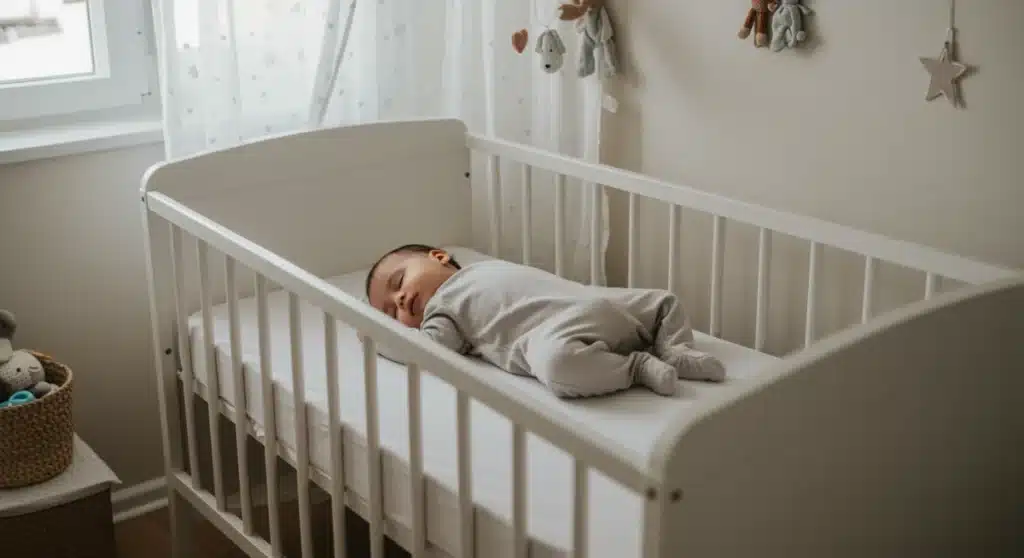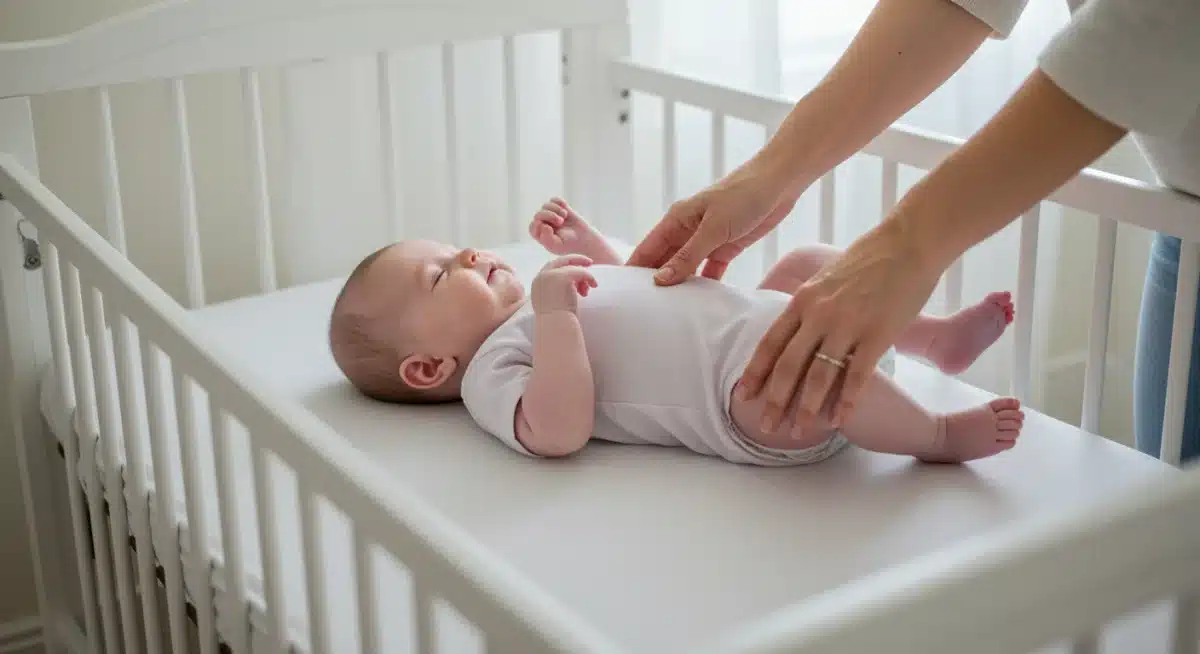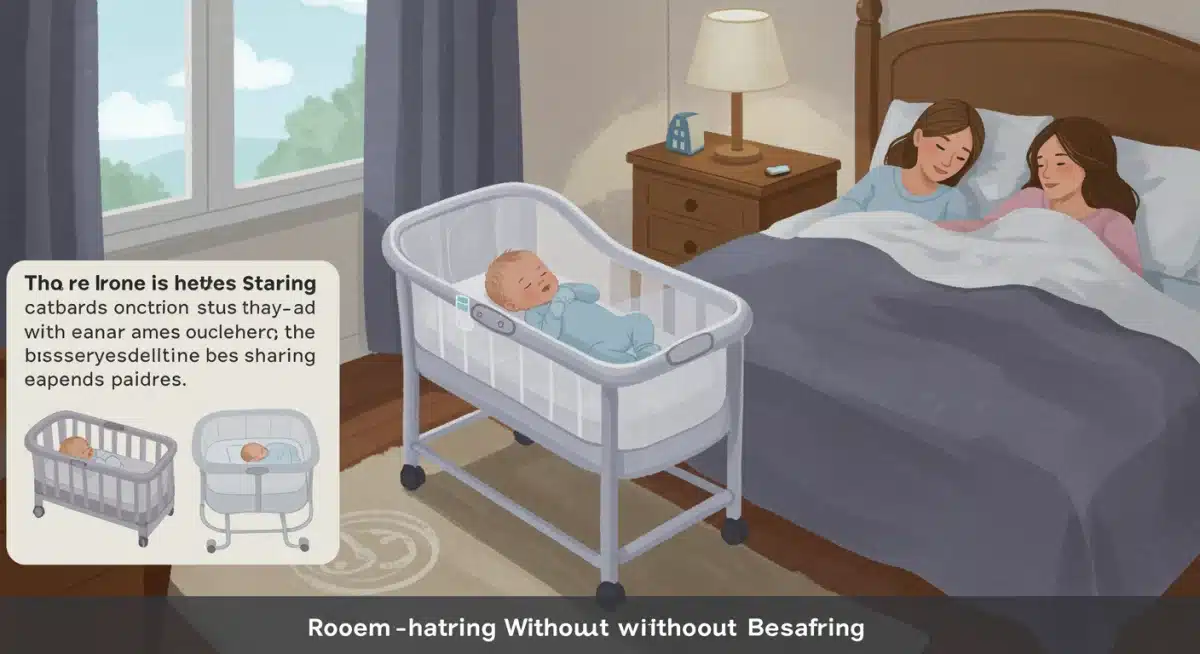Safe Sleep Practices: Reducing Risk of SIDS 2025

Advertisement
Implementing evidence-based safe sleep practices is paramount for parents to minimize the risk of Sudden Infant Death Syndrome (SIDS), ensuring a secure sleep environment for their infants.
Navigating the early days of parenthood brings immense joy, but also significant responsibility, especially when it comes to your baby’s well-being. One of the most critical aspects of infant care is understanding and implementing safe sleep practices: reducing the risk of SIDS in 2025. This comprehensive guide will equip you with the essential knowledge to create a secure sleep environment for your little one, offering peace of mind and promoting healthy development.
Advertisement
understanding SIDS and its impact
Sudden Infant Death Syndrome (SIDS) is the unexplained death, usually during sleep, of a seemingly healthy baby less than a year old. While the exact cause remains elusive, research has identified several factors that can significantly increase or decrease a baby’s risk. Understanding these factors is the first step toward proactive prevention.
SIDS is a devastating and often unexpected event for families. It typically occurs between 1 and 4 months of age, but it can happen anytime during the first year. The medical community continues to research SIDS, aiming to uncover more definitive causes and even more effective preventative measures. For parents, staying informed about the latest recommendations is crucial.
what is SIDS?
SIDS is a diagnosis of exclusion, meaning it’s made after all other potential causes of death have been ruled out through a thorough investigation, including a complete autopsy, examination of the death scene, and review of the infant’s clinical history. It’s often referred to as “crib death” due to its association with sleep.
Advertisement
- Unexplained death of an infant under one year of age.
- Occurs suddenly and unexpectedly during sleep.
- Diagnosis made after extensive investigation.
how common is SIDS?
While SIDS rates have significantly declined since the “Back to Sleep” campaign began in the 1990s, it remains a leading cause of death for infants between one month and one year of age. The rates vary by demographic and region, but every parent should be aware of the risks and how to mitigate them. Continuous public health efforts are vital to further reduce these numbers.
The good news is that through widespread education and adherence to safe sleep guidelines, millions of lives have been saved. However, vigilance is still necessary, as even one SIDS death is too many. Parents play a crucial role in continuing this positive trend by adopting recommended practices.
In conclusion, SIDS is a serious concern for new parents, characterized by the sudden and unexplained death of an infant during sleep. While its exact causes are not fully understood, understanding its prevalence and the factors that contribute to it is essential for implementing effective prevention strategies. Awareness is the first line of defense.
the ‘back to sleep’ campaign: a cornerstone of safety
The “Back to Sleep” campaign, now known as “Safe to Sleep,” revolutionized infant care by advocating for placing babies on their backs to sleep. This simple yet profound change has been credited with a dramatic decrease in SIDS rates worldwide. It’s a fundamental principle that every parent should adhere to without exception.
Initially launched in 1994, this initiative has become synonymous with SIDS prevention. Its success underscores the power of public health campaigns in changing behaviors and saving lives. The message is straightforward: babies sleep safest on their backs, every time, for every sleep.
why back sleeping matters
Research indicates that babies sleeping on their stomachs are at a significantly higher risk of SIDS. This position can lead to rebreathing exhaled air, overheating, or obstruction of the airway. Placing a baby on their back ensures an open airway and reduces these risks.
- Reduces risk of rebreathing exhaled air.
- Prevents airway obstruction.
- Helps regulate body temperature.
implementing ‘back to sleep’ consistently
It’s vital to place your baby on their back for every sleep, whether it’s a short nap or overnight sleep. This practice should be consistent from birth until the baby reaches one year of age. Even if your baby can roll over independently, it’s still best to start them on their back.
Some parents worry about babies spitting up or choking while on their back. However, a baby’s anatomy naturally prevents this; their airway is positioned above the esophagus. The benefits of back sleeping far outweigh these unfounded concerns. Always ensure your baby is placed on their back initially.
The “Back to Sleep” campaign remains a critical component of safe sleep practices. By consistently placing infants on their backs for all sleep times, parents can significantly lower the risk of SIDS. This simple action is one of the most effective preventative measures available.

creating a safe sleep environment
Beyond placing your baby on their back, the physical sleep environment plays a crucial role in SIDS prevention. A safe sleep space is one that is free from hazards and designed to support your baby’s safety throughout the night and during naps. Every item in the crib or bassinet should be carefully considered.
Parents often receive many gifts for their new baby, including cute blankets and soft toys. While well-intentioned, many of these items can pose a suffocation or strangulation risk in a baby’s sleep area. Prioritizing safety over aesthetics is key when setting up the nursery.
the ideal sleep surface
Your baby should sleep on a firm, flat surface, such as a crib mattress covered with a fitted sheet. Sofas, armchairs, and adult beds are not safe sleep surfaces for infants, as they can increase the risk of suffocation or entrapment.
- Firm, flat mattress.
- Fitted sheet only.
- Avoid soft surfaces like couches or adult beds.
clearing the sleep area of hazards
The crib or bassinet should be completely clear of loose bedding, bumpers, pillows, and soft toys. These items can obstruct a baby’s airway or lead to overheating. A bare crib is the safest crib.
Many parents use crib bumpers thinking they protect their baby from bumping into the sides of the crib. However, these bumpers have been linked to infant deaths due to suffocation or strangulation. It’s a common misconception that they enhance safety, when in fact, they introduce risks. Always opt for a minimalist approach to the crib.
Establishing a safe sleep environment is paramount for reducing SIDS risk. This includes ensuring your baby sleeps on a firm, flat surface and keeping their sleep area completely free of loose items that could pose a hazard. A simple and uncluttered crib is the safest choice for your infant.
room-sharing vs. bed-sharing: understanding the difference
While both room-sharing and bed-sharing involve a baby sleeping near their parents, their safety implications are vastly different. Understanding this distinction is vital for making informed decisions about your baby’s sleep arrangements. One is strongly recommended, while the other is highly discouraged.
Many cultures historically practiced bed-sharing, and some parents find it convenient for nighttime feedings. However, modern research has highlighted the significant risks associated with bed-sharing, especially in certain circumstances. It’s important to weigh these risks against any perceived benefits.
the benefits of room-sharing
The American Academy of Pediatrics (AAP) recommends room-sharing, but not bed-sharing, for at least the first six months, and ideally for the first year. Room-sharing means the baby sleeps in their own separate sleep space (crib or bassinet) in the parents’ bedroom. This arrangement allows for close monitoring and easier nighttime feedings while maintaining a safe environment.
- Easier for parents to feed and comfort the baby.
- Allows for close monitoring of the infant.
- Reduces SIDS risk compared to bed-sharing.
why bed-sharing is risky
Bed-sharing, where the baby sleeps in the same bed as a parent or other caregiver, significantly increases the risk of SIDS and accidental suffocation. Risks include entrapment between the mattress and headboard, suffocation by a sleeping adult, or entanglement in adult bedding.
Factors like parental fatigue, the use of alcohol or drugs, and soft mattresses further amplify the dangers of bed-sharing. While the desire to bond with your baby is strong, it’s crucial to prioritize their safety. Consider placing the crib right next to your bed for close proximity without the dangers of bed-sharing.
In summary, room-sharing, where the baby sleeps in their own crib or bassinet in the parents’ room, is a recommended safe sleep practice. Conversely, bed-sharing carries significant risks and should be avoided to protect your infant from SIDS and accidental suffocation. Prioritize a separate, safe sleep space.

temperature control and avoiding overheating
Maintaining an optimal room temperature and dressing your baby appropriately for sleep are crucial elements of safe sleep practices. Overheating has been identified as a risk factor for SIDS, making temperature control an important consideration for parents. A comfortable baby is a safe baby.
It’s natural for parents to want to keep their baby warm and cozy, especially during colder months. However, excessive bundling or a warm room can quickly lead to overheating, which can be dangerous for infants. Learning to gauge your baby’s comfort level is important.
optimal room temperature
The ideal room temperature for a sleeping baby is generally between 68 and 72 degrees Fahrenheit (20-22 degrees Celsius). The room should feel comfortable for a lightly clothed adult. Avoid extreme temperatures, both too hot and too cold.
- Keep room between 68-72℉ (20-22℃).
- Ensure the room is comfortable for an adult.
- Avoid placing cribs near windows or vents.
dressing your baby for sleep
Dress your baby in light sleep clothing, such as a one-piece sleeper, rather than heavy pajamas or multiple layers. A sleep sack or wearable blanket can be used as an alternative to loose blankets, providing warmth without the risk of entanglement or suffocation. Check your baby’s temperature by feeling their chest, not their hands or feet.
A good rule of thumb is to dress your baby in one more layer than you would wear to be comfortable in the same room. If your baby is sweating, has damp hair, or a red face, they are likely too warm. Adjust their clothing or the room temperature accordingly to prevent overheating.
Proper temperature control and appropriate sleepwear are vital for preventing overheating, a known SIDS risk factor. Ensure the room is comfortably cool and dress your baby in light layers or a sleep sack, checking their temperature regularly to ensure they are not too warm.
pacifier use and other protective factors
While the primary focus of SIDS prevention lies in creating a safe sleep environment, certain other factors have been shown to offer additional protective benefits. One of the most notable is pacifier use during sleep. Incorporating these protective factors can further enhance your baby’s safety.
Parents often have questions about pacifier use, wondering if it’s beneficial or detrimental. For SIDS prevention, current research strongly supports its use. However, it’s essential to introduce it correctly and understand its role within the broader context of safe sleep guidelines.
the protective effect of pacifiers
Studies have shown that pacifier use during sleep can reduce the risk of SIDS. The mechanism isn’t fully understood, but it’s thought that pacifiers may help keep the airway open or make it easier for babies to arouse from deep sleep. If your baby takes a pacifier, offer it at naptime and bedtime.
- Reduces SIDS risk during sleep.
- Mechanism possibly involves airway opening or arousal.
- Offer at every nap and bedtime.
important considerations for pacifier use
It’s crucial not to force a pacifier if your baby doesn’t want it. If you’re breastfeeding, wait until breastfeeding is well established (usually around 3-4 weeks) before introducing a pacifier to avoid nipple confusion. Do not attach pacifiers to strings or clips that could become a strangulation hazard.
Always ensure the pacifier is clean and appropriately sized for your baby. Replace pacifiers regularly as they wear out. Remember, while pacifiers offer a protective effect, they are an adjunct to, not a replacement for, other safe sleep practices. The core principles of back sleeping and a clear crib remain paramount.
Pacifier use during sleep is a recognized protective factor against SIDS, offering an additional layer of safety for infants. While beneficial, it should be introduced thoughtfully and never forced, always adhering to other established safe sleep guidelines. It complements, but does not substitute, other critical practices.
addressing common myths and misconceptions
Despite widespread education, several myths and misconceptions about infant sleep safety persist. These can inadvertently put babies at risk. It’s essential for parents to distinguish between evidence-based recommendations and outdated or incorrect advice. Clearing up these misunderstandings is critical.
Grandparents and well-meaning friends might offer advice based on practices from decades ago. While their intentions are good, some of these old practices are now known to be unsafe. Parents should feel empowered to follow current guidelines, even if they contradict traditional beliefs.
myth: tummy sleeping prevents choking
A common misconception is that babies should sleep on their stomachs to prevent choking on spit-up. However, a baby’s anatomy naturally protects their airway, and studies show that back sleeping does not increase the risk of choking. In fact, stomach sleeping increases the risk of SIDS.
- Back sleeping does not increase choking risk.
- Baby’s anatomy is designed to prevent choking.
- Stomach sleeping is a SIDS risk factor.
myth: crib bumpers are safe and necessary
Many parents believe crib bumpers protect babies from injury. However, crib bumpers pose suffocation, strangulation, and entrapment hazards, and there is no evidence that they prevent serious injuries. The safest crib is one without bumpers.
Another myth suggests that babies need special wedges or positioners to keep them on their backs. These products are not recommended and can be dangerous, as they can cause infants to become trapped or suffocate. Always use a firm, flat mattress without any additional positioning devices.
Dispelling common myths is crucial for promoting safe sleep practices. Parents should rely on current, evidence-based recommendations, such as back sleeping and keeping the crib clear of bumpers and positioners, rather than outdated advice. Informed decisions lead to safer sleep for infants.
| Key Safe Sleep Practice | Brief Description |
|---|---|
| Back to Sleep | Always place infants on their backs for all sleep times, including naps. |
| Safe Sleep Surface | Use a firm, flat mattress in a crib or bassinet, covered with only a fitted sheet. |
| Clear Sleep Area | Keep cribs free of loose blankets, pillows, bumpers, and soft toys. |
| Room-Sharing | Baby sleeps in parents’ room in a separate crib or bassinet, not in the same bed. |
Frequently Asked Questions about Safe Sleep
The safest sleeping position for your baby is on their back. This practice, known as “Back to Sleep,” significantly reduces the risk of SIDS. Always ensure your baby is placed on a firm, flat surface for every sleep, whether it’s a nap or overnight.
No, bed-sharing is not recommended due to increased risks of SIDS and accidental suffocation. The American Academy of Pediatrics advises room-sharing, where your baby sleeps in their own crib or bassinet in your room, but not in the same bed.
Crib bumpers are not safe and are not recommended. They pose risks of suffocation, strangulation, and entrapment. The safest crib is one that is completely bare, with only a firm mattress and a fitted sheet. Prioritize a clear sleep space.
Yes, studies suggest that pacifier use during sleep can help reduce the risk of SIDS. If your baby accepts a pacifier, offer it at naptime and bedtime. However, do not force it, and ensure breastfeeding is well-established first.
To prevent overheating, keep the room temperature between 68 and 72 degrees Fahrenheit. Dress your baby in light sleep clothing, such as a one-piece sleeper or a sleep sack, and avoid heavy blankets or excessive layers. Check their chest for warmth.
conclusion
Ensuring your baby’s safety during sleep is one of the most important responsibilities of parenthood. By consistently adhering to current safe sleep practices: reducing the risk of SIDS in 2025, you can significantly mitigate the risk of Sudden Infant Death Syndrome. This includes always placing your baby on their back, providing a firm and clear sleep surface, practicing room-sharing without bed-sharing, controlling the room temperature, and considering pacifier use. Staying informed and vigilant about these guidelines empowers parents to create the safest possible environment for their precious little ones, fostering healthy growth and peaceful nights for the entire family. Every decision made regarding your baby’s sleep should prioritize their safety and well-being above all else, ensuring a secure foundation for their development.





